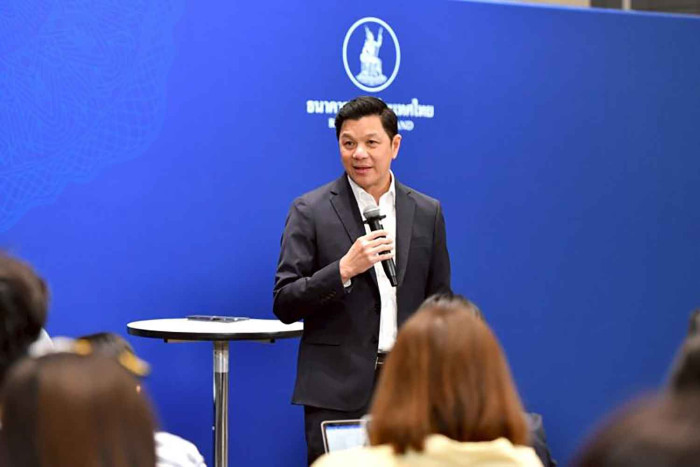
Central bank governor Vitai Ratanakorn
The Bank of Thailand expects asset management companies (AMCs) to absorb 20% of non-performing loans (NPLs) to help improve bad debt management in the banking industry.
Speaking at the BAM Symposium hosted on Tuesday by Bangkok Commercial Asset Management Plc (BAM), the country’s largest AMC, central bank governor Vitai Ratanakorn said Thailand has around 90 AMCs that collectively absorb about 10% of the country’s total bad debt, down from 20% in past years.
“We expect the NPL absorption ratio to return to 20%. Ideally, it should rise even higher — to 25%, 30% or even 35%,” said Mr Vitai.
He said the central bank is considering extending the application period for financial institutions to establish joint venture AMCs (JV-AMCs), after the previous deadline expired at the end of 2024. The extension is expected to be announced later this week, said Mr Vitai.
There are three JV-AMCs in operation: JK AMC, Ari AMC and Arun AMC. JK AMC is a partnership between Kasikornbank (KBank) and JMT Network Services, while Arun AMC is a collaboration between KBank and BAM. Ari AMC is a joint venture between BAM and Government Savings Bank.
He said financial institutions including commercial banks, specialised financial institutions, non-bank lenders, and AMCs are expected to show renewed interest in establishing JV-AMCs once the application period is extended.
This expansion would increase market participants and help alleviate the country’s household debt and NPL burden, said Mr Vitai.
The country’s household debt-to-GDP ratio is around 86%. NPLs and special mention (SM) loans in the banking sector account for 3-4% and 8-9%, respectively — representing 11-12% of Thailand’s total household debt, according to the central bank.
Regarding the Finance Ministry’s initiative to address household debt, which focuses primarily on NPLs of less than 100,000 baht per debtor, he said the central bank and relevant agencies are cooperating, with a measure expected to be finalised within two weeks.
There are around 4 million borrowers with NPLs of less than 100,000 baht, and the initiative is expected to assist 1.5-2 million of them through debt restructuring. Although this measure will not cover a large portion of total NPLs, it will provide significant relief to small retail borrowers, helping them exit the NPL cycle and regain financial stability, while also supporting domestic consumption and the Thai economy over the long term, said Mr Vitai.
Under the central bank’s NPL management framework through the AMC mechanism, Ari AMC primarily handles the NPLs of financial service institutions, while Sukhumvit Asset Management Company — a central bank-owned entity — manages NPLs for banks and non-bank lenders, serving as a “social AMC”.
Rak Vorrakitpokatorn, chief executive of BAM, said the NPL ratio in the banking sector has continued to rise — from 532 billion baht in the fourth quarter of 2024, to 548 billion and 555 billion in the first and second quarters of 2025, respectively.
Meanwhile, the combined NPL and SM ratio in the banking industry reached 11.5% of total outstanding loans in the second quarter of this year, up from 7.25% during the pandemic. During the 1997 financial crisis, the NPL and SM ratio peaked at 17.7%.
“Given the ongoing increase in NPLs, BAM is ready to collaborate with all relevant parties to tackle the problem,” Mr Rak said during the seminar.
“We plan to shift our focus from NPL management to re-performing loan management, seeking to ease the country’s household debt and NPL challenges.”

